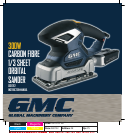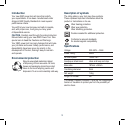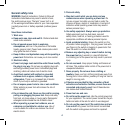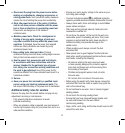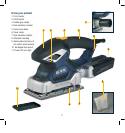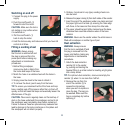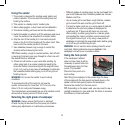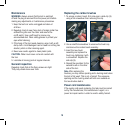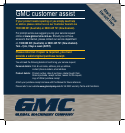
9
Using the sander
1. The sander is designed for sanding wood, plastic and
similar materials. It can be used for sanding back and
finishing the surface.
2. This sander is a handy size for medium jobs.
3. Wear safety goggles, a dust mask and ear defenders.
4. The whole sanding pad must rest on the workpiece.
5. Switch the sander on while it is off the workpiece and move
it over the surface to be smoothed in a circular motion.
6. Grip the rear of the handle (2) in one hand and push
down on the front of the handle with the other hand. Take
care to hold the sander parallel to the work.
7. Use moderate pressure only, enough to control the
machine without labouring the motor.
TIP. When sanding a rough or painted surface, start off with
a course grit and work your way through to a finer one until
the desired finish is achieved.
8. If there are still marks on your work after sanding, try
either going back to a coarser grade and sanding the
marks out before recommencing with the original choice
of grit, or try using a new piece of sandpaper to eliminate
the unwanted marks before going on to a finer grit and
finishing the job.
WARNING. Do not use the sander in wet or damp
conditions.
To maximise the life of the motor do not use the
sander continuously for more than 10-15 min at a time.
Allow 5-10 min rest period between usage.
The manufacturer recommends the use of a residual current
device with a tripping current of 30mA or less.
Selecting the right grade of sandpaper
WARNING. Always ensure that the tool is switched
off and the plug is removed from the power point before
making any adjustments or maintenance procedures.
• Different grades of sanding paper can be purchased from
your local hardware store. Available grades are: Coarse,
Medium and Fine.
• Use a coarse grit to sand down rough finishes, medium
grit to smooth the work and fine grit to finish off.
• It is best to make a trial run on a scrap piece of material
to determine the optimum grades of sandpaper for
a particular job. If there are still marks on your work
after sanding, try either going back to a coarser grade
and sanding the marks out before recommencing with
the original choice of grit, or try using a new piece of
sandpaper to eliminate the unwanted marks before going
on to a finer grit and finishing the job.
WARNING. Do not use the same sanding sheet for wood
and metal. Metal particles become embedded in the
sandpaper and will scour a wooden surface.
Using the hole punch
If the sandpaper installed
does not have holes it will be
necessary to punch holes into
the sandpaper using the hole
punch (10) provided.
Place the hole punch on a
level surface.
After fitting the sandpaper to the sander align the base
of the sander with the hole punch and push down on the
sander until the hole punch pierces the sandpaper.
Remove the sander from the hole punch.
TIP: Depending on the paper used, you may need to use a
pointed screwdriver to open and clear the holes to increase
the efficiency of dust extraction.



